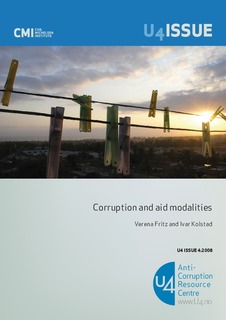| dc.contributor.author | Fritz, Verena | |
| dc.contributor.author | Kolstad, Ivar | |
| dc.date.accessioned | 2018-01-04T08:16:11Z | |
| dc.date.available | 2018-01-04T08:16:11Z | |
| dc.date.issued | 2008-08-01 | |
| dc.identifier | oai:www.cmi.no:3102 | |
| dc.identifier.citation | Bergen: Chr. Michelsen Institute (U4 Issue 2008:4) 25 p. | |
| dc.identifier.uri | http://hdl.handle.net/11250/2474595 | |
| dc.description.abstract | The introduction of ‘new' aid modalities - and in particular general budget support - has increased the interest in the relationship between corruption and aid modalities. This U4 Issue reviews the information that theory and empirical studies provide on the prevalence of corruption in relation to various aid modalities, the degrees to which corruption distorts the developmental impact of different aid modalities, and whether aid modalities affect the governance environment and corruption in a country differently. It concludes that the choice of aid modality will not affect aid allocation nor accountability in countries with relatively low levels of aid, regardless of the level of corruption. With high aid dependency, however, donors have some more control over aid allocation with project than with budget support. Where this is the case, and corruption is high, there are strong reasons for not choosing budget support as an aid modality. | |
| dc.language.iso | eng | |
| dc.publisher | Chr. Michelsen Institute | |
| dc.relation | U4 Issue | |
| dc.relation | 2008:4 | |
| dc.relation.ispartof | U4 Issue | |
| dc.relation.ispartofseries | U4 Issue 2008:4 | |
| dc.relation.uri | https://www.cmi.no/publications/3102-corruption-and-aid-modalities | |
| dc.subject | Corruption | |
| dc.subject | Anti-Corruption | |
| dc.subject | Corruption in Aid | |
| dc.subject | Public Financial Management and Procurement | |
| dc.title | Corruption and Aid Modalities | |
| dc.type | Research report | |
